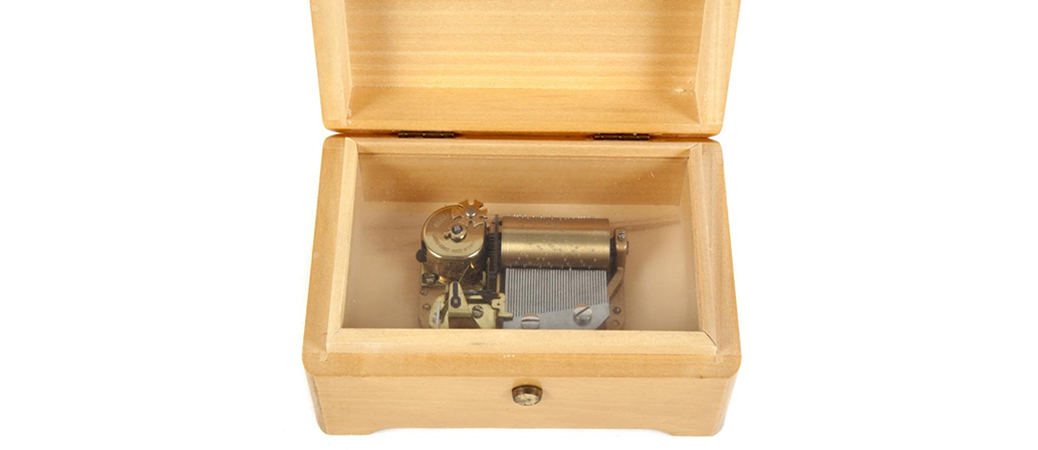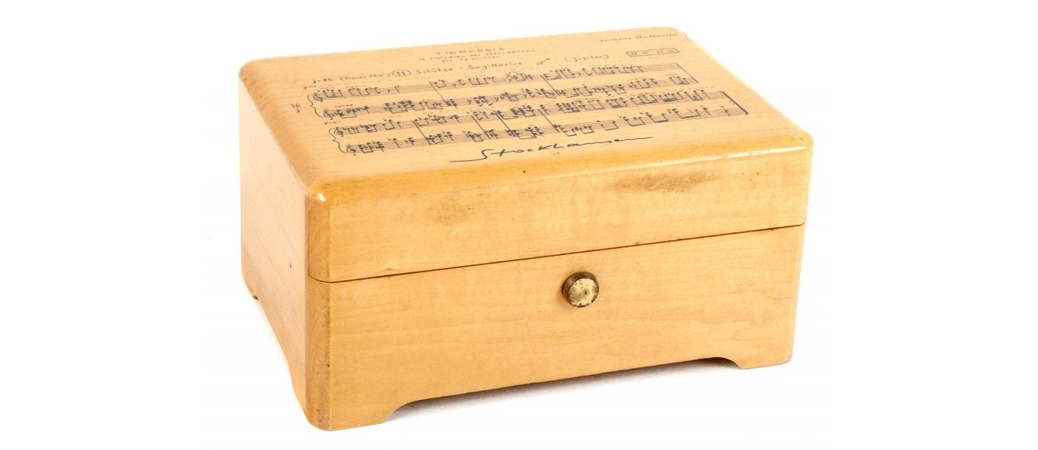Stockhausen Zodiac music boxes
The first series of Stockhausen Zodiac music boxes was manufactured in 1974 by the Reuge Music Box Company (Ste. Croix, Switzerland) with the personal collaboration of Stockhausen. He wrote special “music box” scores for each of the 12 melodies of the Zodiac. At that time three different sizes of “claviers” (28 or 36 or 50 lamellae) were used, depending upon the pitch demands of each melody. A “clavier” is a thin piece of special, resonant metal alloy with a “tongue” (lamella) or two for each pitch in the melody. It is necessary to have two or more lamellae for the same pitch if the same pitch occurs in rapid succession or in close proximity to itself.
Stockhausen personally visited the Reuge factory in 1974 in order to receive instructions about how to notate scores for music box production and to learn what the “rules” were for composing for music boxes. He then notated the 12 music boxes in the score MUSIK IM BAUCH (MUSIC IN THE BELLY) for 6 percussionists and music boxes, Work No. 41. This work is recorded on CD 24 of the Stockhausen Complete Edition, together with all 12 of the music boxes. Both the score and the CD may be ordered directly from the Stockhausen-Verlag.
In 1974 the music boxes were still being produced by hand. Women coated the cylinders with egg yolk and then pierced them at just the right place. How to find that “place” had to be specially indicated by Stockhausen in his music box score because of the unusual rhythms (triplets!) he used in some of the Zodiac melodies. He wrote exactly how many cylinder rotations (or half-rotations, third-rotations or quarter-rotations) forwards and backwards would produce the necessary rhythm (= positions of the holes). Then little pins which pluck the clavier were inserted into these holes and held firmly in place by a special glue with which the inside of the cylinder was coated.
The lamellae of the claviers were tuned by hand. Each lamella was plucked and the pitch checked using tuning devices. The pitch of the lamella was adjusted by filing the lead “beard” beneath each lamella until all of the notes of the clavier – a different “scale” for each melody – were correct and in tune. The final touch was to glue a tiny little bird feather on the underside of each of the lamellae to reduce the sympathetic vibration caused by the proximity of the lamellae to each other. Until the mid 80s, the Reuge company distributed Stockhausen’s Zodiac music boxes under exclusive licence. The boxes of this first series are slightly smaller in size than those of the subsequent series.
From about 1985 to 1998, Reuge was no longer able to manufacture Stockhausen’s Zodiac music boxes due to the computerization of their manufacturing process and due to the special expertise necessary for the fine tuning of both the rhythm and the pitch of the boxes.

In 1998, again with the personal collaboration of Stockhausen, new prototypes were made using 50-lamellae claviers for all 12 melodies in order to make computer production possible. This involved rewriting the scores, because now only 50 lamellae were available instead of 28 or 36 or 50 as before. Stockhausen therefore had to renotate the music box scores for 8 of the 12 melodies without changing a note of the melodies. These scores were fed into a special computer programme for making music box arrangments. Tape cassette recordings of the resultant computer-driven synthesizer simulation of the computerized manufacturing process for the Zodiac music boxes were sent to Kuerten for several series of corrections before a new series of 40 boxes for each of the 12 Zodiac melodies could be produced by Reuge. This time, they were to be distributed exclusively by the Stockhausen-Verlag.
The fine adjustments were made in February 1998 on location in Ste. Croix with the collaboration of Suzanne Stephens and Antonio Pérez Abellán. Part of the fine adjustment involved checking the duration of the melodies using stop watches, to make sure that the tempi were exact. In doing this it had to be taken into account that the mechanism of the music boxes runs faster in Ste. Croix (altitude: 1,000 metres) than in Kuerten and most of the rest of the world at lower altitudes. Therefore, depending on the melody, the “finissage” (= the little windmill that propels the mechanism) had to be adjusted (Antonio’s specialty) so that the duration was 1 to 2 seconds shorter in Ste. Croix than indicated in the score (on the top of each music box). The “1 or 2 seconds shorter” was a result of sending prototypes from Ste. Croix to Kuerten and noting the timing differences, using stop-watches.
Due to the great demand for these boxes, a new series had to be manufactured in the course of 2005. These were checked by Suzanne and Antonio on location in Ste. Croix for a week in October 2005. They spent about 50 hours each checking the 480 so-called “movements”, which are the cylinders and claviers not yet mounted into the box. Two technicians (in rooms adjacent to those where Suzanne and Antonio were working) simultaneously carried out the adjustments upon receipt of a movement which was accompanied by a photocopy of the melody with hand-written indications of the corrections which were to be made. When the technicians had carried out the corrections, the movements were sent back tray-wise (8 movements per tray), and sometimes they had to be sent back a second and third time until they were perfect. About 240 movements (of 480) were sent back the first time, 120 the second time, and 60 the third time. Several movements were sent back 5 or 6 times. The first corrections were made in pencil by both Suzanne and Antonio, the second ones were made in green by Suzanne and in blue by Antonio, the third ones were made in red (!!!!) and the fourth, fifth and sixth ones were verbal, standing next to the the technician as he worked.
478 boxes (2 got lost) were delivered in November 2005 and all were individually checked again. 13 of them were sent back to Ste. Croix for further adjustment, and of those 13 which were returned to us after adjustment by Reuge, 5 had to be returned. They are still in Ste. Croix.
We are happy to announce that they are now available for purchase. We have had to raise the price to 310 € (447 $) from that set in 1998, because Reuge raised the production costs significantly. We have not raised our price as much as Reuge raised theirs. But we are thankful that they managed to make them at all, because in the meantime, Reuge no longer manufactures the 50 lamellae model, and made an exception for us.
This may be the last series manufactured by Reuge, so it would be wise not to delay your decision to invest in these unique music boxes.
It is significant that even the pioneer of electronic music let himself be enchanted by the poetry and magic of these little boxes which, the moment they begin to sound, transform the world into a timeless fairy tale, and transform us into timeless children.
